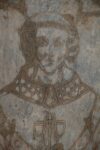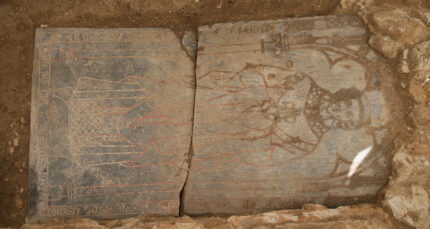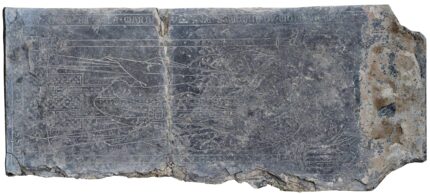A striking funerary slab with original red paint highlighting its engraved surface still present has been unearthed in Saint-Quentin, northern France. The tomb dates to 1305 and is engraved with the effigy of a robed cleric inside a Gothic arch. The surviving parts of the inscription around the arch identify the deceased as a “chaplain in the church of Monsignor Quentin.” Red paint was applied in the engraved lines of the effigy of the cleric, the border arch and the lettering of the inscription to make the design stand out against the blue stone. The paint often fades to nothingness over time. The red on this slab is still remarkably visible even before conservation.
The city of Saint-Quentin was founded as Augusta Veromanduorum, the Roman capital of the local Viromandui people, during the reign of Augustus (27 B.C. – 14 A.D.). Its location on the Somme river at the crossroads of two important roads made it a commercial center for the region.
In the 4th century it gained new prominence as the purported site of the martyrdom of Caius Quintinus, aka Quentin of Amiens. Quentin was a Roman Christian who followed his missionary zeal to convert the Gauls and was arrested and tortured for his activities. He was able to briefly escape custody in Augusta Veromanduorum, but he just started evangelizing on the spot, so he was tortured, beheaded and his body tossed into the Somme. Years later his remains were found in the marshes and buried on the hill in the middle of the city. A shrine was built there which quickly became a popular site of pilgrimage.
A church was built over the tomb and then expanded and rebuilt numerous times. A community of monks was established there in the 7th century and administered the shrine, but the local count replaced them with secular canons in the 10th century. The current basilica was constructed between the 12th and 15th centuries. It suffered great damage in World War I and it took more than 20 years (plus another world war) to repair and reconstruct it.
 In March of this year, archaeologists began to excavate the south side of the basilica in downtown Saint-Quentin. A cloister was known to have stood there in the 14th century, and the excavation quickly confirmed its presence when it encountered the remains of the cloister’s north gallery. In the courtyard between the galleries, a space frequently used for burials in medieval monasteries, the team discovered several burials. One contained a deposit of multiple pottery vessels; another from the Merovingian era had a single intact bowl deposited next to the head of the deceased.
In March of this year, archaeologists began to excavate the south side of the basilica in downtown Saint-Quentin. A cloister was known to have stood there in the 14th century, and the excavation quickly confirmed its presence when it encountered the remains of the cloister’s north gallery. In the courtyard between the galleries, a space frequently used for burials in medieval monasteries, the team discovered several burials. One contained a deposit of multiple pottery vessels; another from the Merovingian era had a single intact bowl deposited next to the head of the deceased.
Three tombs were of particular note because they were covered by funerary slabs made of Tournai blue stones. These were reserved for burials of important members of the religious community, specifically the canons. The slab of the canon who died in 1305 is the only one of the three with such a well-preserved carved and painted surface. Another grave covered with a blue stone slab was discovered during an archaeological survey at the site in 2017. It is similarly engraved for the grave of a canon who died in 1302. No paint has survived, however.

